Xian Tours
Beijing Tours
China Tour Packages
About
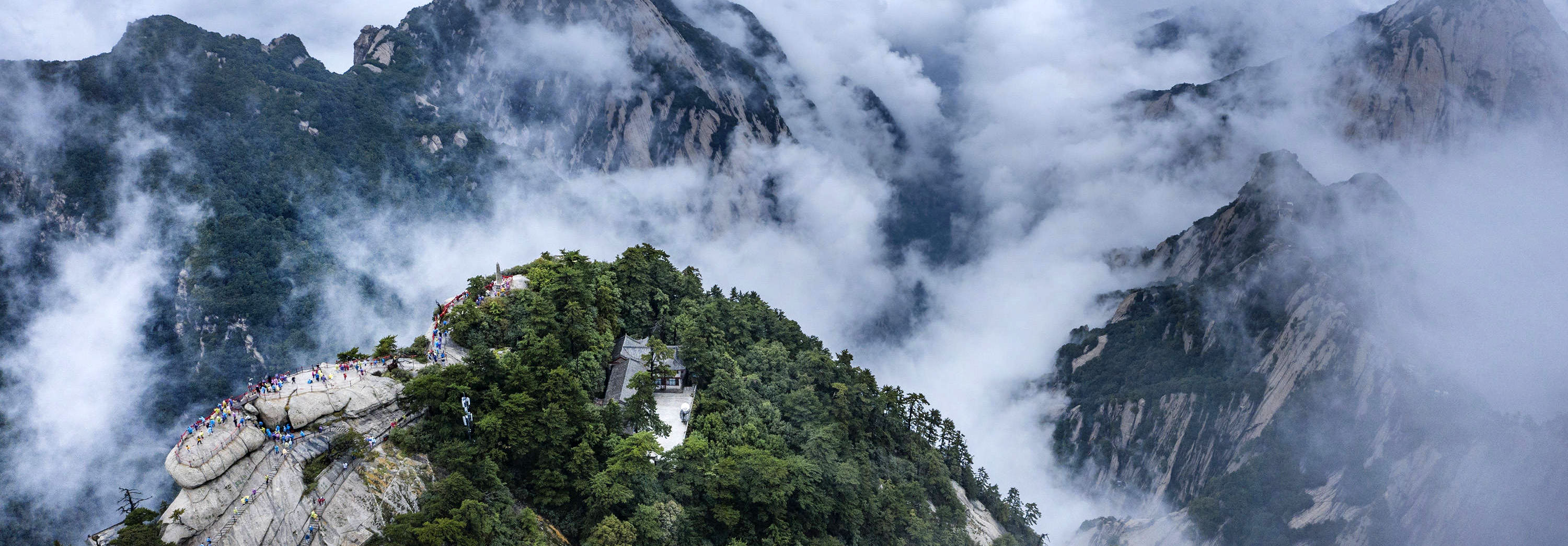
Mt. Hua is situated in Huayin County of Weinan City, about 120 kilometers from Xi’an. Mt. Hua rises up from the Weihe Plateau and on the bank of Yellow River. It is part of the Qin Ling Mountain Range that divides not only northern and southern Shaanxi, but also China.
The peak of Mt. Hua has an amazing altitude of 2,155 meters, the highest of the “Five Mountains of China”. 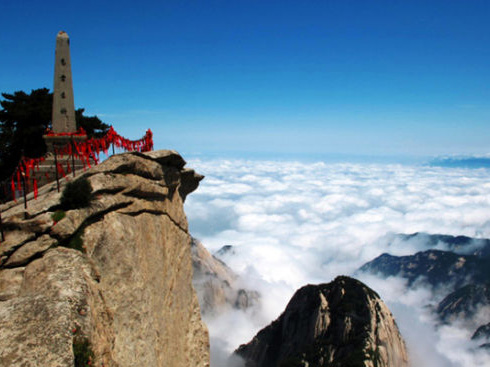 Mt. Hua was recorded in ancient documents and has a long history of religious significance. It is rich in history and culture, and there is an abundance of interesting sights. . According to textual research of the famous scholar Zhang Taiyan of the Qing Dynasty, the Hua of "Zhong Hua” and "Hua Xia" are all named from the Hua Mountain. The Mountain is famous for its dangerous cliff. The cliff is almost vertical to the ground and there are no natural paths to the top of the mountain. Those who have admired the magnificence of Mt. Hua all marveled at its incredible beauty. Temples and pavilions were built on rocks on the mountain. Sometimes the buildings appear to be hanging in the air. Nowadays, Mt. Hua attracts millions of travelers every year.
Mt. Hua was recorded in ancient documents and has a long history of religious significance. It is rich in history and culture, and there is an abundance of interesting sights. . According to textual research of the famous scholar Zhang Taiyan of the Qing Dynasty, the Hua of "Zhong Hua” and "Hua Xia" are all named from the Hua Mountain. The Mountain is famous for its dangerous cliff. The cliff is almost vertical to the ground and there are no natural paths to the top of the mountain. Those who have admired the magnificence of Mt. Hua all marveled at its incredible beauty. Temples and pavilions were built on rocks on the mountain. Sometimes the buildings appear to be hanging in the air. Nowadays, Mt. Hua attracts millions of travelers every year.
As early as the 2nd century BCE, there was a Taoist temple known as the Shrine of the Western Peak located at its base. Taoists believed that the god of the underworld lived in the mountain. The temple at the foot of the mountain was often used for spirit mediums to contact the god and his subordinates.  Unlike Taishan, which became a popular place of pilgrimage, Huashan only received Imperial and local pilgrims because of its inaccessibility to the summit, and was not well visited by pilgrims from the rest of China. Huashan was also an important place for seekers of immortality, as many herbal Chinese medicines are grown and powerful drugs were reputed to be found there. Kou Qianzhi (365–448), the founder of the Northern Celestial Masters received revelations there, as did Chen Tuan (920–989), who spent his last years living as a hermit on the west peak. In the 1230s, all the temples on the mountain came under control of the Taoist Quanzhen School.[2] In 1998, the management committee of Huashan agreed to turn over most of the mountain's temples to the China Taoist Association. This was done to help protect the environment, as the presence of taoists and nuns deters poachers and loggers.
Unlike Taishan, which became a popular place of pilgrimage, Huashan only received Imperial and local pilgrims because of its inaccessibility to the summit, and was not well visited by pilgrims from the rest of China. Huashan was also an important place for seekers of immortality, as many herbal Chinese medicines are grown and powerful drugs were reputed to be found there. Kou Qianzhi (365–448), the founder of the Northern Celestial Masters received revelations there, as did Chen Tuan (920–989), who spent his last years living as a hermit on the west peak. In the 1230s, all the temples on the mountain came under control of the Taoist Quanzhen School.[2] In 1998, the management committee of Huashan agreed to turn over most of the mountain's temples to the China Taoist Association. This was done to help protect the environment, as the presence of taoists and nuns deters poachers and loggers.
There are two walking trails leading to Huashan's North Peak (1614 m), the lowest of the mountain's five major peaks. The most popular is the traditional route in Hua Shan Yu (Hua Shan Gorge) first developed in the 3rd to 4th century A.D. and with successive expansion, mostly during the Tang Dynasty.  It winds for 6 km from Huashan village to the north peak. A new route in Huang Pu Yu (Huang Pu Gorge, named after the hermit Huang Lu Zi who lived in this gorge in 8th century BC) that follows the cable car to the North Peak is actually the ancient trail used prior to the Tang Dynasty, which has since fallen into disrepair. It had only been known to local villagers living nearby the gorges until 1949, when a group of 7 People’s Liberation Army (PLA) with a local guide used this route to climb to the North Peak and captured over 100 Kuomintang (KMT) soldiers stationed on the North Peak and along the traditional route. This trail is now known as "The Route Intelligent Take-over of Hua Shan" and was reinforced in early 2000. The Cable Car System stations are built next to the beginning and ends of this trail. Visiting the mountain by cable car is another good choice for visitors. On the east side of the Yuquan Temple, there is an approx. 8 kilometer long (about 5 miles long) concrete road leading up to Wamiaogou where you can take a cable car directly to the North Peak. The top station is located on the east cliff of the North Peak. The whole ride is more than 1,500 meters (about 4,921 feet) long and takes seven to eight minutes.
It winds for 6 km from Huashan village to the north peak. A new route in Huang Pu Yu (Huang Pu Gorge, named after the hermit Huang Lu Zi who lived in this gorge in 8th century BC) that follows the cable car to the North Peak is actually the ancient trail used prior to the Tang Dynasty, which has since fallen into disrepair. It had only been known to local villagers living nearby the gorges until 1949, when a group of 7 People’s Liberation Army (PLA) with a local guide used this route to climb to the North Peak and captured over 100 Kuomintang (KMT) soldiers stationed on the North Peak and along the traditional route. This trail is now known as "The Route Intelligent Take-over of Hua Shan" and was reinforced in early 2000. The Cable Car System stations are built next to the beginning and ends of this trail. Visiting the mountain by cable car is another good choice for visitors. On the east side of the Yuquan Temple, there is an approx. 8 kilometer long (about 5 miles long) concrete road leading up to Wamiaogou where you can take a cable car directly to the North Peak. The top station is located on the east cliff of the North Peak. The whole ride is more than 1,500 meters (about 4,921 feet) long and takes seven to eight minutes.
For many years most people have taken a traditional but 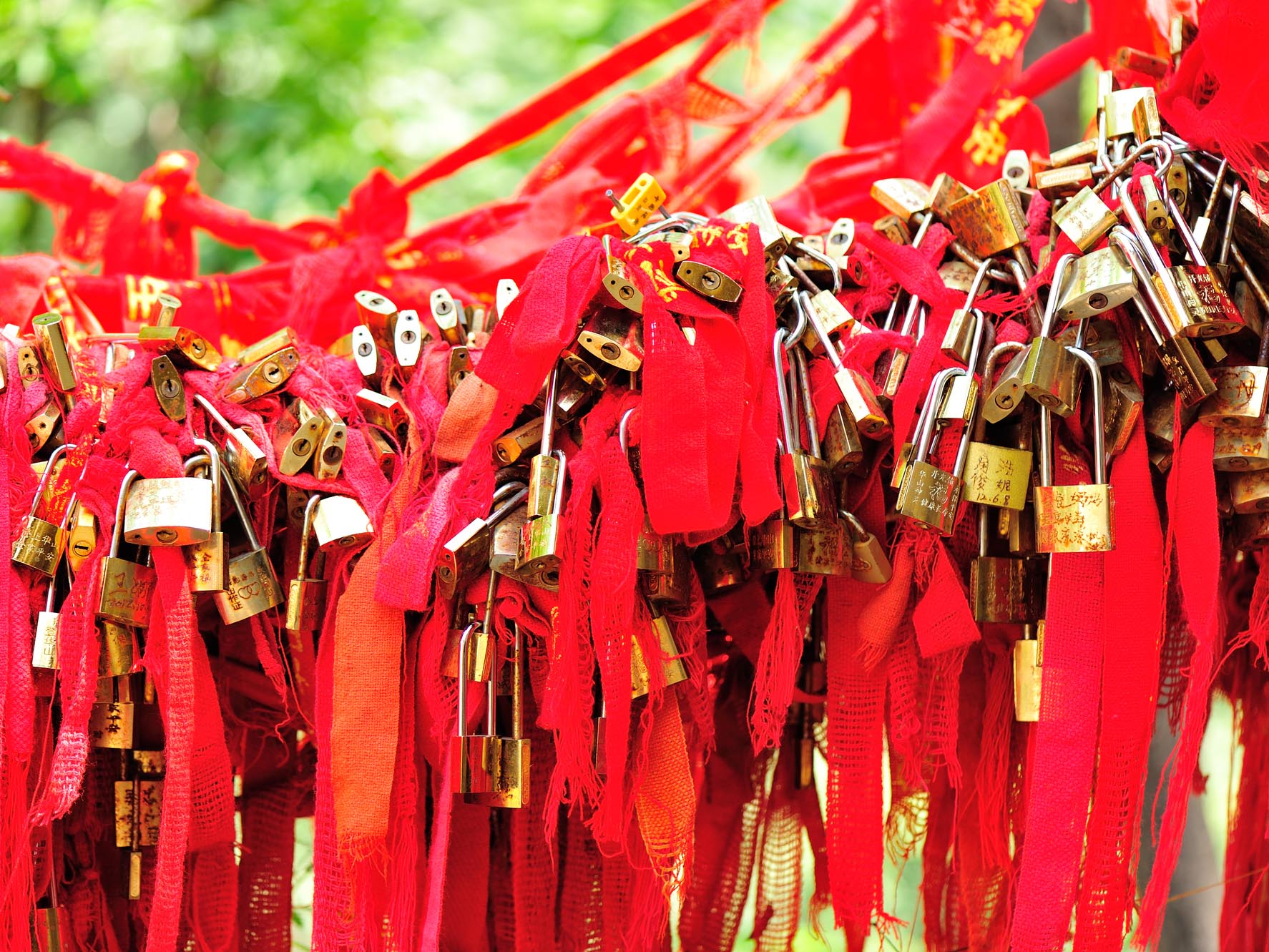 efficient walking-ascending and cable-car-descending route for this mountain climbing. By taking this route, visitors can experience not only its danger, but also the major meaningful scenic spots. At the foot of Mt. Huashan, you can start your trip by visiting the Jade Spring Temple. After that, you can walk to the Memorial Archway in about 15 min, and then in 5 min you will get to the Five Dragon Bridge, next to which is the ticket office.
efficient walking-ascending and cable-car-descending route for this mountain climbing. By taking this route, visitors can experience not only its danger, but also the major meaningful scenic spots. At the foot of Mt. Huashan, you can start your trip by visiting the Jade Spring Temple. After that, you can walk to the Memorial Archway in about 15 min, and then in 5 min you will get to the Five Dragon Bridge, next to which is the ticket office.
Climbing to the top of the East Peak takes 4 to 6 hours. It has an altitude of 2,090 meters (about 6,857 feet), forming a platform for visitors to view the sunrise. An astronomical telescope is provided here. The reference time for sunrise is between 5:00.-6:00. in spring, 4:30-5:20. in summer, 5:00-5:20 in autumn and 5:30-6:00 in winter.
One well-known scenic spot, the Immortal's Palm Peak, ranked as one of the Eight Scenic Wonders of the Guanzhong Area (the plain in the middle of Shaanxi Province), is located on the East Peak. It refers to the natural rock veins of the cliff, which look like a giant palm-print.  The legend goes that on March 3rd of the Lunar Calendar a torrential flood destroyed the villages within the Mt. Huashan area. This disaster was caused by the Queen Mother of the West, who held her Flat Peach Carnival celebration that year. She carelessly spilled a little jade wine down from paradise, causing a serious flood below. This news was quickly reported by Deity Shaohao to the Jade Emperor in the Celestial Paradise. He gave a prompt order to Deity Juling to go down to tame the flood. When Deity Juling, full of vigor and vitality, descended from the clouds, he arrived at the precipitous cliff of East Peak. At the moment that he laid his left hand on one side and his right leg on the other, he ripped the mountain into two halves and immediately a flood rushed out. This tale adds luster to the East Peak.
The legend goes that on March 3rd of the Lunar Calendar a torrential flood destroyed the villages within the Mt. Huashan area. This disaster was caused by the Queen Mother of the West, who held her Flat Peach Carnival celebration that year. She carelessly spilled a little jade wine down from paradise, causing a serious flood below. This news was quickly reported by Deity Shaohao to the Jade Emperor in the Celestial Paradise. He gave a prompt order to Deity Juling to go down to tame the flood. When Deity Juling, full of vigor and vitality, descended from the clouds, he arrived at the precipitous cliff of East Peak. At the moment that he laid his left hand on one side and his right leg on the other, he ripped the mountain into two halves and immediately a flood rushed out. This tale adds luster to the East Peak.
After enjoying the sunrise at the East peak, you can descend using the following route in case you have missed some scenic spots: East Peak – about 35 min to Heavenly South Gate – 5 min to Plank Road – 25 min to Heaven Watching Pool – 5 min to South Peak – 35 min to West Peak – 15 min to Middle Peak – 20 min back to Black Dragon Ridge – 25 min to Macaque Sorrow – 5 min to North Peak.
South Peak (Landing Wild Geese Peak)
With an altitude of 2,160 meters (about 7,087 feet), the South Peak is regarded 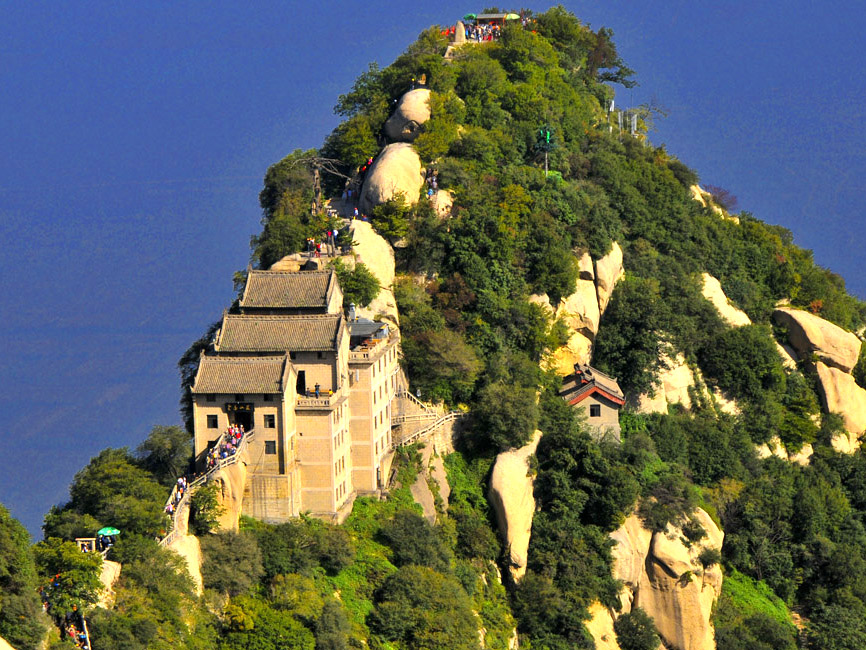 as the monarch of the mountain because it is the highest peak of Mt. Huashan and also the highest peak among the Five Sacred Mountains of China. Visitors who summit South Peak are undoubtedly winners. Looking around when standing on the peak, the surrounding landscapes are luxuriantly green; the Yellow River wanders far below and everything seems small. A legend goes that the wild geese returning from the south often landed at South Peak, giving the area the name Landing Wild Geese Peak.
as the monarch of the mountain because it is the highest peak of Mt. Huashan and also the highest peak among the Five Sacred Mountains of China. Visitors who summit South Peak are undoubtedly winners. Looking around when standing on the peak, the surrounding landscapes are luxuriantly green; the Yellow River wanders far below and everything seems small. A legend goes that the wild geese returning from the south often landed at South Peak, giving the area the name Landing Wild Geese Peak.
At the top of the South Peak, the Black Dragon Pool at the summit and the Greeting Pines on the southwestern cliff are two attractive resorts. At each side of the Landing Wild Goose Peak there are two peaks, Songhui Peak (Pine and Juniper Peak) in the east and Xiaozi Peak (Filial Son Peak) in the west. The three peaks form a picture of a Titan sitting in a chair. The most dangerous place is Plank Road, a plank path built along the side of a vertical cliff, about 0.3 meters (about 1 foot) wide. Below is a bottomless gulf which makes visitors shake with fear. In addition, there is a Taoist temple called Baidi Temple or Jintian Palace, considered to be the host temple of the Deity Shaohao.
West Peak (Lotus Flower Peak)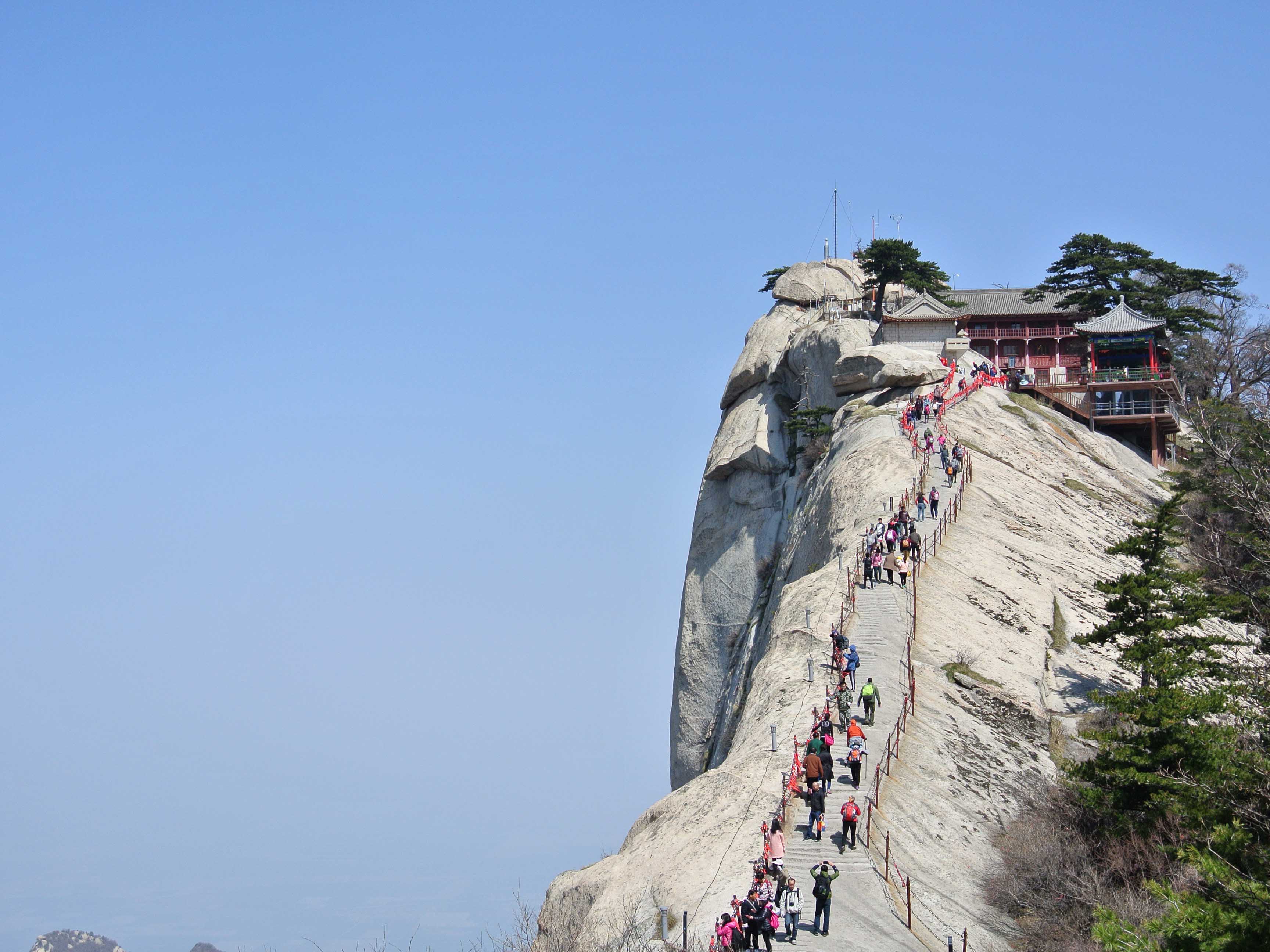
West Peak has very high cliffs standing erect with an altitude of 2,086.6 meters (about 6,845 feet). There is a Taoist temple called Cuiyun Palace, before which a huge rock looking like a lotus flower comes into view, hence the name Lotus Flower Peak. There are another seven rocks beside Cuiyun Palace, which is said to be the place where Chenxiang (a main character in the movie Lotus Lantern) ripped the mountain to save his mother (The Heavenly Goddess San Sheng Mu).
Middle Peak (Jade Maiden Peak)
Middle Peak clings to the East Peak and is in the center of the East, 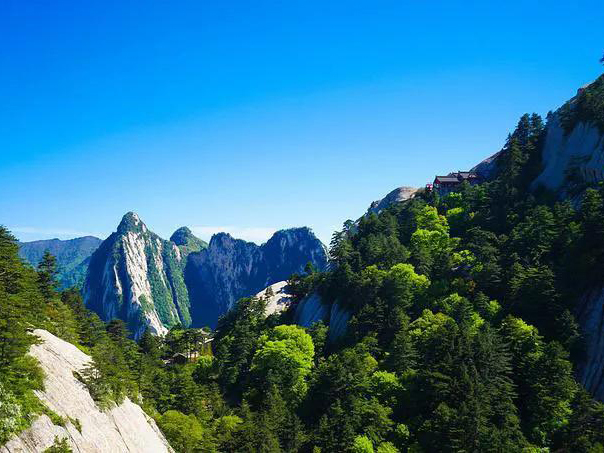 South and West Peaks. There is a Taoist temple on the peak named Jade Maiden Temple. Legend has it that the daughter of Qin Mugong (569 - 621 BC) loved a man who was good at playing Chinese tung-hsiao (vertical flute) and she gave up the royal life to become a hermit who cultivated her spirituality here, hence the name Jade Maiden Peak. Today Jade Maiden Temple and Jade Maiden Basin for Shampooing can be found on the peak. Other scenic spots in the Middle Peak include Rootless Tree and Sacrificing Tree, which have beautiful stories and add to the supernatural atmosphere of the Middle Peak.
South and West Peaks. There is a Taoist temple on the peak named Jade Maiden Temple. Legend has it that the daughter of Qin Mugong (569 - 621 BC) loved a man who was good at playing Chinese tung-hsiao (vertical flute) and she gave up the royal life to become a hermit who cultivated her spirituality here, hence the name Jade Maiden Peak. Today Jade Maiden Temple and Jade Maiden Basin for Shampooing can be found on the peak. Other scenic spots in the Middle Peak include Rootless Tree and Sacrificing Tree, which have beautiful stories and add to the supernatural atmosphere of the Middle Peak.
North Peak (Cloud Terrace Peak)
There are precipitous cliffs on all sides of the North Peak, 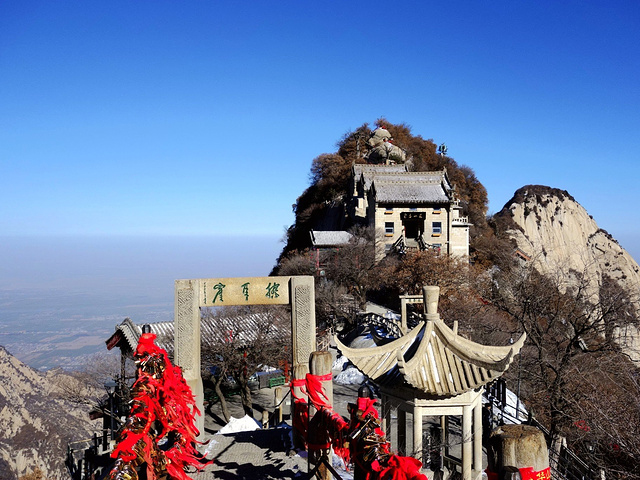 making it look like a flat terrace in the clouds, hence the name Cloud Terrace Peak. It is 1,614 meters (about 5,295 feet) high. Three sides are cliffs and one side is to the Ear-Touching Cliff, which is the fourth precipitous path where visitors can climb up only by pressing an ear close to the cliff. Almost halfway up the North Peak trees are luxuriantly green, creating a good resting spot.
making it look like a flat terrace in the clouds, hence the name Cloud Terrace Peak. It is 1,614 meters (about 5,295 feet) high. Three sides are cliffs and one side is to the Ear-Touching Cliff, which is the fourth precipitous path where visitors can climb up only by pressing an ear close to the cliff. Almost halfway up the North Peak trees are luxuriantly green, creating a good resting spot.
Location: Huayin County, Weinan, Shaanxi,120 kilometers or two hours drive away from Xian
Opening Time: Dec-Feb: 9:00 to 17:00
Mar-Nov: 7:00 to 19:00
Ticket Price: Mar-Nov: RMB180 yuan per person
Dec-Feb: RMB 160 yuan per person
Visiting Time: one day
Mt.Hua Day Tour with Foot Massage Mt Huashan Day Tour by Train 2 Days Adventure Xian Tour to Mt.Hua 3 Days Xian Adventure Tour with Mt. Huashan
Copyright © 2019 Lily Sun China Tours International, Inc. Terms &conditions | Privacy Policy | Sitemap